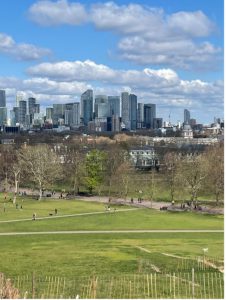This guest blog comes from Abbie Russell, Engagement Officer and Sustainability Champion at the Institute of Psychiatry, Psychology & Neuroscience (IoPPN). With contribution from Louise Bolderstone, James Hollands, and Annicka Ancliff.
With this year’s Mental Health Awareness Week theme of ‘Nature’, we couldn’t not talk about our local green spaces – the value they bring. For some of us, visiting the local park has been a highlight of the day or the week during lockdown. There’s a lot of research, including IoPPN research, that suggests that exposure to trees, the sky and birdsong in cities is beneficial for mental wellbeing.
One thing I do miss about working on campus is going for lunchtime walks through the park (shout out to Ruskin Park near Denmark Hill Campus!) with colleagues. It was so nice, that the Bee Team (aka IoPPN Main Building Sustainability Champions) organised regular lunchtime walks, the Ruskin Park Appreciation Walks, and we would be joined by colleagues from all over the faculty. It was a great chance to network, share ideas, research, and meet new people.
When lockdown hit – we decided to keep the conversation going online, with Teams meetings and a refresh of the Yammer group. We changed the name to Local Park Appreciation. This allowed us to open up this space to the entire King’s community and it now has 111 active members.
In this blog we explore some of the groups favourite local green spaces.
Hilly Fields, South East London (Abbie Russell, IoPPN)
My favourite thing about South East London is the number of great parks and amount of green space. I’ve recently discovered Hilly Fields since moving to a new house and it’s my new favourite sunrise spot. From the top of the hill, you can see for miles – trees in one direction, and city in the other.
Hilly Fields is in Brockley and is surrounded by lots of other green spaces: One Tree Hill, Ladywell Fields, and Peckham Rye Park.

Beckenham Place Park (Louise Bolderstone, Research Management and Innovation)
In the last year I have got to know Beckenham Place Park even better as it has been the focus of my weekends and I have walked in it with a friend most weeks, although prior to that I was a regular visitor. My appreciation and knowledge of this wonderful place has expanded in an equal proportion to the contractions of my horizon.
The park has benefited from additional funding in the last few years contributing to a place that provides a variety of activities for everyone, from open water swimming to exploring the ancient woodland to relaxing with some food or drink from the onsite café. However, its true value lies in the space afforded to everyone to enjoy by virtue of it being the largest park in the borough and at times, it feels like the entire borough is trying to squeeze in. That does not detract from enjoying its beauty though because there is always a way to find a solitary path. I get a sense of calm from walking around and seeing all of the different plants, trees and greens offering a counterbalance to the craziness of the world during these last months. I love the twisted trees that have stood there for so many years and I have comfort knowing they have been there through many trials and continue to stand.
I have witnessed a transformation in the park’s popularity in the last year but its natural lifecycle has continued regardless. The bluebells are nearly out again, after the carnival of daffodils. Snow has surprised everyone and covered the open greens and settled gently in the woods. The parakeets continue to reign supreme and the wild meadow areas have sprung up and down again hosting kaleidoscopes of butterflies and hardworking bees. There is peace and life co-existing simultaneously in this place and it brings me joy to see the old and the new living in harmony. No matter what the next year brings, I know that Beckenham Place Park will be there.
 .
. 
Greenwich Park (James Hollands, Registry Services)
During lockdown, the importance of getting outside and seeing green spaces has never been more important – both for our physical and mental health. As I live in Woolwich, one of my favourite walks has been walking along the Thames Path to Greenwich, and then walking along around Greenwich Park.
Located near to the River Thames in South-East London, the park is open all year round and is listed as Grade I on the Register of Historical Parks and Gardens. During London 2012 it was used for Olympic equestrian events as well as the Modern Pentathlon. The park has a large sweeping green space which means even when the park is busy, you can walk around it easily. The park is home to several tree and plant species, which means that even in wintertime, there is something out in bloom, and it also has lovely clean fresh air.
The park is on 2 levels, and at the top of the hill in the park is the Royal Observatory, which the prime meridian passes through. There is also a beautiful view at the top of the hill from which you can see Canary Wharf and the National Maritime Museum. I love to be able to sit and look at these views, whilst enjoying the tranquillity of the park.
I would recommend giving the park a visit. It is a short walk from Greenwich railway station, Greenwich Pier, and multiple bus routes.


Southwark Park (Annicka Ancliff, Research & Development, IoPPN)
In the last few months, Southwark Park has been my favourite walking/running spot. I used to follow the Thames Path on walks but since there are more people out and about I have preferred the park to avoid the crowds.
There was one run in particular which will always stay in my memory and that was the other day. It was so sunny and the park was buzzing, I saw a few runners and other people either using the outdoor gym or doing other fitness activities. In the course of my run, I was greeted by a tiny puppy which was an absolute delight and then a little girl offered (or possibly showed) me a flower I kept running past her but shouted my thanks at her.
It has been so nice to see people enjoying the parks more as the weather has improved and the lockdown has been eased.

What about your own local parks? Let us know and get involved online.
All King’s staff and students are welcome to join the Local Park Appreciation group on Yammer.


 .
. 








